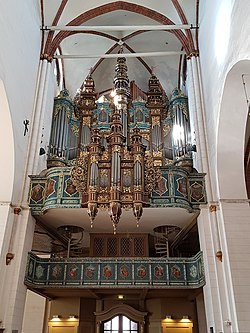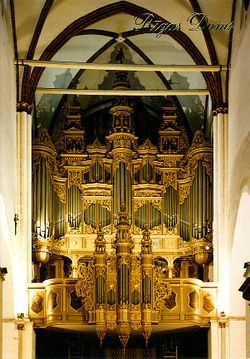Riga, Dom
Adresse: Herdera laukums 6, Centra rajons, Rīga, LV-1050, Lettland
Gebäude: Ev.-luth. Rīgas Doms
| Orgelbauer: | E. F. Walcker |
| Baujahr: | 1882/83 |
| Geschichte der Orgel: | 1601 Neubau mit 3 Manualen (III+P/42) siehe auf orgbase.nl
1733 Umbau und Erweiterung um die Pedaltürme durch Andreas Contius 1829 Erweiterung, die Orgel hatte nun 52 Register 1882/83 Neubau durch E. F. Walcker aus Ludwigsburg (Opus 413), mit Wiederverwendung des Prospekts und der stummen Prospektfeifen (IV+P/124, damals größte und modernste mechanische Orgel) 1959-62 Generalreparatur und Wiederherstellung alter Pfeifen durch H. Eule, Bautzen (nach Beschädigungen im 2. Weltkrieg) 1983/84 Restauration durch Orgelbau Flentrop (Zaandam, NL), Rekonstruktion des Zustandes von 1884 |
| Gehäuse: | Jacob Rabe, 1601 |
| Windladen: | Kegelladen |
| Spieltraktur: | mechanisch (Barkermaschine) |
| Registertraktur: | mechanisch |
| Registeranzahl: | 124, 6718 Pfeifen |
| Manuale: | 4, C-f³ |
| Pedal: | C-g' |
| Spielhilfen, Koppeln: | Koppeln: II/I, III/I, IV/I, III/II, IV/II, I/P, II/P, III/P, IV/P, I–IV/P, P/I („noli me tangere“)
Crescendo an/ab Schwelltritt IV+Schwellpedal, Schwelltritt II-Oboe 8'; 18 unterschiedliche Feste Kombinationen (A-S): -A: Alle Koppeln -B: mf Pedal -C: p Pedal -D: pp Pedal -E: pp Schwellpedal -F: f IV. Manual -G: Tutti -H: ff --> Alle Labialen aus I, II, III -I: f --> alle Labialen 16', 8', 4' aus I, II, III -K: mf I, II, III -L: Feste Registerkombination I. Manual #1 -M: Feste Registerkombiantion I. Manual #2 -N: Feste Registerkombination II. Manual #1 -O: Feste Registerkombination II. Manual #2 -P: Feste Registerkombination III. Manual #1 -Q: Feste Registerkombination III. Manual #2 -R: Trompeten-Chor -S: Kombinations-Prolongement[1] Auslöser für jedes Manual Generalauslöser |
- Anmerkungen
- ↑ Das Kombinations-Prolongement ist eine "Freie Kombination", bei der man die einregistrierte Registrierung speichern kann und neben bei schon Register für die nächste Kombination vorbereiten kann.
Disposition
| I. Manual | II. Manual[1] | III. Manual | IV. Manual (SW) | Pedal |
| Principal 16′
Flauto major 16′ Viola di Gamba 16′ Octav 8′ Hohlflöte 8′ Viola di Gamba 8′ Doppelflöte 8′ Gemshorn 8′ Quintatön 8′ Bourdon 8′ Dulciana 8′ Quinte 51/3' Octav 4′ Gemshorn 4′ Gamba 4′ Hohlflöte 4′ Rohrflöte 4′ Terz 31/5' Quinte 22/3' Octav 2′ Superoctav 1′ Sexquialtera II 51/3'[2] Cornet V 8′[3] Mixtur VI 4′ Scharff IV 1 1/3′ Contrafagott 16′ Tuba mirabilis 8′ Trompette harm. 8′ Cor anglais 8′ Euphon 8′ Clairon 4′ Cornettino 2' |
Geigenprincipal 16′
Bourdon 16′ Principal 8′ Fugara 8′ Spitzflöte 8′ Rohrflöte 8′ Concertflöte 8′ Liebl. Gedeckt 8′ Viola di Alta 8′ Dolce 8′ Principal 4′ Fugara 4′ Salicet 4′ Flauto dolce 4′ Quinte 22/3' Superoctav 2′ Waldflöte 2′ Terz 13/5' Sexquialtera II 22/3' Cornet V 8′[4] Mixtur V 22/3' Äolodicon 16′ Ophykleide 8′ Fagott-Oboe 8′ Oboe 4′ Tremolo |
Salicional 16′
Lieblich Gedeckt 16′ Geigenprincipal 8′ Viola d’amour 8′ Wienerflöte 8′ Gedeckt 8′ Salicional 8′ Harmonika 8′ Bourdon d’echo 8′ Bifra 8′+4′[5] Geigenprincipal 4′ Spitzflöte 4′ Traversflöte 4′ Dolce 4′ Piccolo 2′ Mixtur IV 22/3' Vox humana 8′ Basson 8′ Clarinette 8′ Tremolo |
Quintatön 16′
Flötenprincipal 8′ Unda maris 8′[6] Melodica 8′ Flûte traversière 8′ Bourdon doux 8′ Äoline 8′ Voix céleste 8′ Viola tremolo 8′[7] Piffaro 8′+2′ Flötenprincipal 4′ Gedecktflöte 4′ Vox angelica 4′ Salicet 2′ Harmonia ätheria III 22/3' Trompete 8′ Physharmonika 8′ |
Hauptpedal
Principal 32′ Grand Bourdon 32' Octav 16′ Violonbass 16′ Contraviolonbass 16′ Subbass 16′ Flötenbass 16′ Gedecktbass 16′ Quint 102/3' Octavbass 8′ Hohlflötenbass 8′ Gedecktbass 8′ Violoncello 8′ Terz 62/5' Octavbass 4′ Hohlflöte 4′ Octav 2′ Sesquialtera II 102/3'[8] Mixtur V 51/3' Bombardon 32′ Posaune 16′ Trompete 8′ Corno 4′ Schwellpedal Violon 16′ Bourdon 16′ Dolceflöte 8′ Violon 8′ Viola 4′ Flautino 2′ Serpent 16′ Bassethorn 8′ |
- Anmerkungen
Bibliographie
| Literatur: | Orgelgeschichte und Disposition aus der Orgelbeschreibung von Orgelbau Walcker |
| Discographie: | The Organ of the Riga Dom (CD, Rigas Skanu Ierakstu Studija, 1997) |
| Weblinks: | Beschreibung und Fotos auf orgbase.nl |
Videos
Demonstration of the 124 Stops Walcker Organ from 1883 in Riga – János Pálúr:
J.S. Bach: Toccata and Fugue in D minor BWV 565 – Liene Andreta Kalnciema (live):
F. Liszt: Prelude and Fugue on B-A-C-H – Liene Andreta Kalnciema (live):
Max Reger: Zwölf Stücke für Orgel op. 65, No. 1–3 – Christoph Bossert:
Max Reger: Präludium e-Moll op. 59 Nr. 1 – Martin Sander:
Max Reger: Phantasie und Fuge über BACH – Martin Sander (live):
Max Reger: Variationen und Fuge über ein Originalthema fis-Moll op. 73 – Martin Sander:


